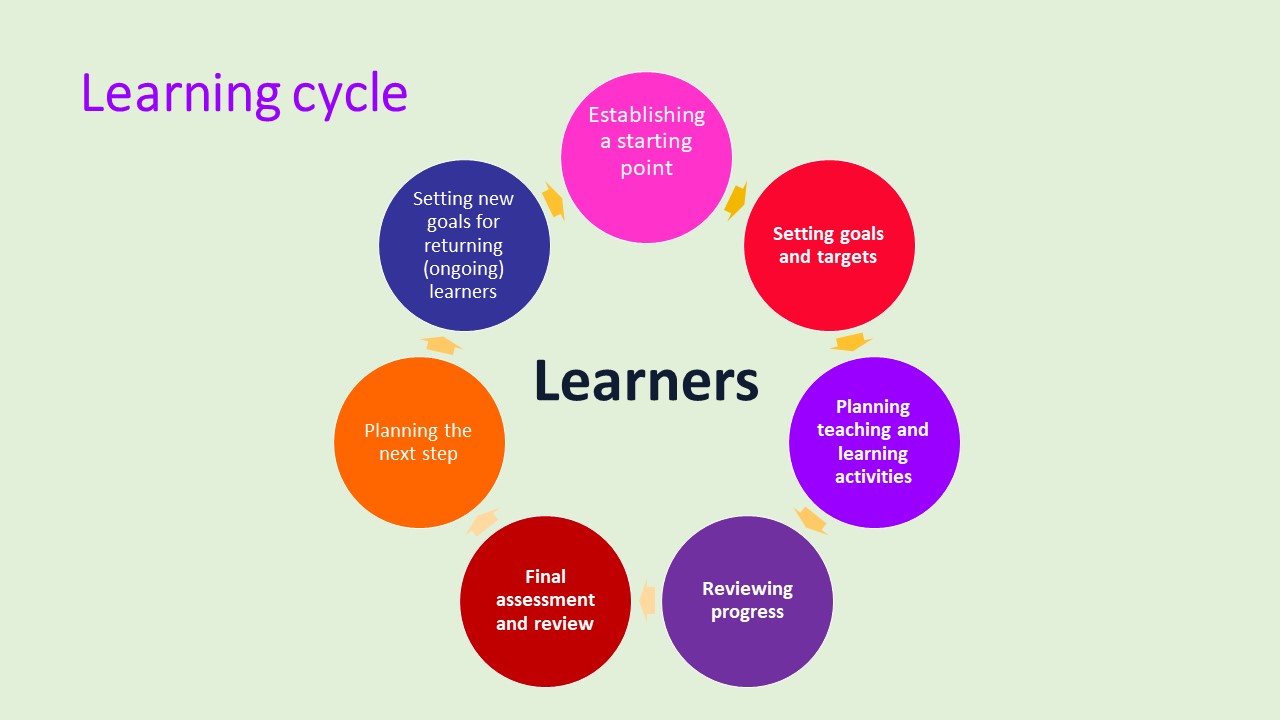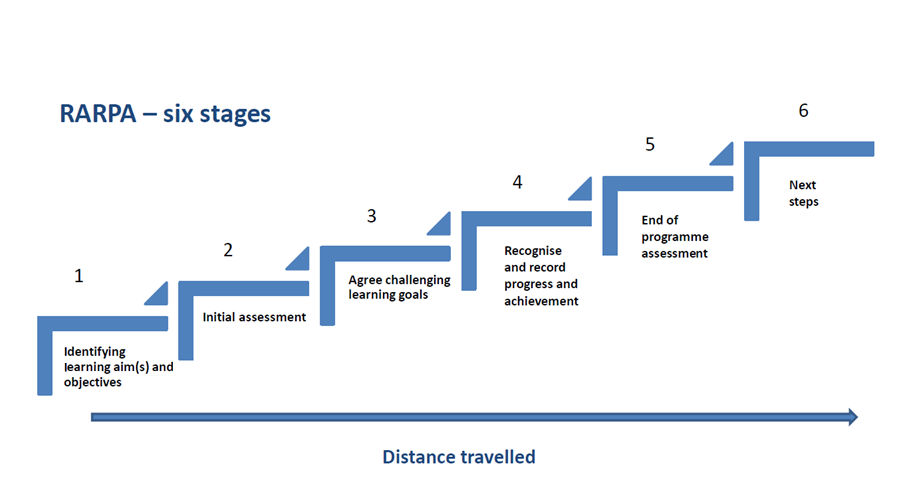Recognising and Recording Progress and Achievement (RARPA)
| Site: | Hampshire Participation and Lifelong Learning |
| Course: | Tutor Handbook |
| Book: | Recognising and Recording Progress and Achievement (RARPA) |
| Printed by: | Guest user |
| Date: | Saturday, 13 December 2025, 10:42 AM |
Table of contents
- Introduction
- The Six Stage Process of RARPA
- Stage 1 Identifying Learning Aims & Objectives
- Stage 2 Initial Assessment
- Stage 3 Challenging Learning Goals
- Stage 4 Recording Progress
- Stage 5 End of Programme Assessment – a review of overall progress and achievement
- Stage 6 Next Steps
- Marking and Feedback
- RARPA In Practice
- Success Measures
- Quality Assurance of the RARPA Process
Introduction
Every provider and tutor delivering Adult Community Learning (ACL) programmes (Thrives, Works, Learns) which fall under the criteria detailed in this document must implement the RARPA process into their practice. Evidence of RARPA will form part of the Contract Management and Quality Monitoring process. This learner-centred staged process aims to improve the learning process for each learner by providing reflection of learning and progress at key points. Tutors have a key role in making RARPA engaging and beneficial for every learner; and to ensure that the methods used to record and recognise progress and achievement are appropriate and have value for the learner. The criteria for RARPA applies to non-accredited learning which does not lead to any form of external accreditation (Customised Qualification) or qualifications, irrespective of course duration (for accredited/qualification courses please see relevant sections within the Teaching, Learning Assessment Policy and Procedure).

The Six Stage Process of RARPA
Recognising and Recording Progress and Achievement is a staged approach to ensure that the learner is at the centre of learning, and the learner’s goals are recognised and count towards the success of their learning. All tutors must follow RARPA and ensure they have sufficient evidence to support all five stages.
Stage 1 Identifying Learning Aims & Objectives
Stage 2 Initial Assessment
Stage 3 Challenging Learning Goals
Stage 4 Recording Progress
Stage 5 End of Programme Assessment – a review of overall progress and achievement
Stage 6 Next steps

Stage 1 Identifying Learning Aims & Objectives
The aims and objectives of the course must be made clear to the learner; the course information sheet should state what the course is about and what learners can progress onto after the learning programme. Evidence will include some or all of the following:-
Clearly stated learning aims
Group Learning objectives
Individual Learning Goals
Challenging learning objectives
Identify how this will be recorded (course info sheets/ pre-course marketing/Curriculum Plans
Stage 2 Initial Assessment
Establish the learner’s starting point; what do they already know? What is their previous experience, knowledge or skills of the subject? Identify additional needs in English and maths. Evidence will include some or all of the following:-
- Pre-course questionnaire or telephone call
Online assessment
Identify how this will be recorded (learning logs/skills check/Curriculum Plans/RARPA Toolkit)
Stage 3 Challenging Learning Goals
The setting of learning objectives for individuals or groups should emerge from the initial assessment process; they need to be sufficiently challenging to encourage effort but not so challenging that they de-motivate learners. Evidence will include some or all of the following:-
Agreeing targets – group and individual
Setting SMART targets
Revising targets
Methods of recording (curriculum plans, learner plans)
Stage 4 Recording Progress
Formative assessment is recognising and recording progress and achievement during a programme. It provides feedback to the learners and tutors alike about the ‘distance travelled’ and ‘value added.’ Evidence will include some or all of the following:-
Record the progress of your learners
Show evidence of change to curriculum plans
Make time to provide written and verbal feedback; clear feedback so they can improve their performance
Keep evidence in a course file
Encourage learners to self assess
Review individual and group progress
Review attendance
Identify types of individual or group learning plans (new ones developed to suit specific programme areas)
Stage 5 End of Programme Assessment – a review of overall progress and achievement
Summative assessment is the review of overall progress and achievement at the end of the programme and indicates the ‘value added’ and ‘distance travelled’ by learners during a course or programme. Evidence will include some or all of the following:-
Learner self assessment
Learner evaluations
Tutor summative assessment to include written feedback on their assessed work / learning activities (ILPs)
Evidence of achievements in course files
Photos/video/CD/online
Written documents
Audio
Examples of learners work/ products
Witness statements
Discuss progression and next steps
Documenting advice and guidance
Stage 6 Next Steps
Supporting
learners to make informed choices about their next steps into further learning,
volunteering or employment by providing appropriate individual and/or group
information, advice and/or guidance tailored to need and desired outcomes.
Marking and Feedback
To ensure
all stages of the RARPA process are met we require tutors to mark work (where
appropriate), and to provide all learners with high quality feedback on
any assessed work / learning activities:
feedback can be verbal or written, through peer marking or self assessment
feedback should be clear on where a learner has done well and provide guidance on how a learner can improve
feedback should include areas such as English and maths, especially grammar, spelling and basic arithmetic (where appropriate)
feedback should include areas where learners can develop their skills/understanding/knowledge independently.
Marking will also enable tutors to plan future learning for groups and individuals.
RARPA In Practice
All ACL programme areas need
to use the RARPA toolkit.
Exceptions are for, where appropriate, based on the learner’s needs
family learning courses when the joint family learning plans (HL17a, b, or c) must be used.
or
where a provider wishes to use their own resources that cover all the elements contained in the RARPA Toolkit above; in which case they will need to seek agreement from Hampshire Achieves who will require evidence of the provider’s own resources being fully implemented.
Current supporting Quality Documentation can be downloaded from Skills and Participation VLE.
Success Measures
For non-accredited learning Hampshire Achieves has set the following criteria for its success measure for all courses. Hampshire Achieves requires sub-contracted providers to ensure the following measures are used to support the RARPA process:
- Attendance &
Punctuality data (91% target)
Incl. learner retention meeting expectations
Overall achievement rates (95% target)
Course information sheets including, course objectives and progression opportunities
Course aims and SMART objectives being set
Group objectives and individual goals set and met
Any ‘achieved’ objectives must be fully met
Any ‘achieved’ individual goals must be fully met
Individual learning plans in place
Regular learner reviews taken place
Final products evidence or
Complete portfolios of evidence
Completed learner evaluations reviewed and summarised
Certificates of Achievement presented.
example of calculating
Individual learner Achievement is to be calculated at 75% of learning objectives set.
Quality Assurance of the RARPA Process
The contents of this policy are an integral part of the Hampshire Achieves Quality Improvement Framework, and supports the Education and Skills Funding Agency requirements which states ‘Where you are not delivering a regulated qualification you must ensure that you have appropriate and robust quality assurance processes in place’.
All
ACL providers must have robust processes in place to review and monitor RARPA
as part of their programmes. Hampshire
Achieves will also undertake quality assurance exercises to ensure RARPA is
being effectively implemented across the delivery through for example:
Reviews of achievement/success data
Observations of Teaching and Learning
Monitoring use of Quality documentation
Course Information sheets
Curriculum Plan
Individual Learning Plans
Course evaluations and learner surveys
Contract review meetings.